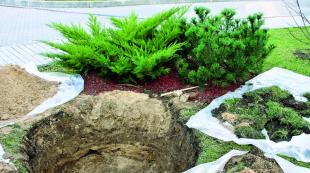An example of the calculation of a bored pile. Detailed calculation of the foundation on bored piles
Pile-grillage foundation on bored piles is a combined type of foundation from supporting piles formed in the ground by concreting wells drilled in the ground. The second part of the foundation is a grillage that distributes the load on the pile field. This type of foundation has the highest bearing capacity and can be used to build big houses and private cottages from any materials.
A bored foundation with a grillage allows you to build buildings on difficult soils: viscous, swampy, quicksand, heaving. The foundation on bored piles is indispensable in seismically active areas, areas with extensive networks of underground utilities, as well as in soils with high alkalinity, where it is impossible to use screw supports.
Design advantages:
- increased resistance to vibration;
- the possibility of construction under adverse geological conditions;
- ease of installation;
- lack of large volumes of earthworks;
- relatively low cost.
It is possible to make a bored foundation with a monolithic grillage without the involvement of specialists and professional equipment.
Disadvantages:
- danger of uneven settlement of supports;
- the impossibility of arranging the basement and basement.
Calculation of a bored foundation with a grillage
When calculating, it is necessary to be guided by the data on the characteristics of soils and materials specified in SNiP 2.03.01-84, 11-23-81, 11-25-80, 2.05.03-84 and 2.06.06-85. In total, three settlement operations are carried out:
Calculation of bored piles
During the calculation, the length of piles (depth of occurrence), their cross section, number and layout are determined. The diameter of a bored pile for the construction of a cottage is from 15 to 40 cm. Most often, this parameter is taken equal to 20 cm. In order not to carry out complex calculations using cumbersome formulas, we suggest using a ready-made table that indicates the bearing capacity of the supports different diameter, as well as the approximate consumption of concrete and reinforcement:
well drilling
Drilling is carried out with a hand drill, which is deepened to the desired depth. When driving, the soil is not thrown to the surface, compacting along the walls.
During the drilling process, it is necessary to control that the drill enters strictly perpendicularly, without deviating.
After the development of the well, the diameter of which should be 5-7 cm larger than the selected diameter of the piles, the base is carefully rammed. If necessary, a sand and gravel cushion of 10-30 cm is added.
Casing installation
Casing pipes prevent the walls of the well from crumbling and ensure safe work. According to the technology, pipes can not be used on dense clay soils and loams, however, when installing bored piles with your own hands, it is recommended to install them. Inside the pipe it is much easier to mount the reinforcing frame. In addition, the process of pouring and vibrating concrete mixture is simplified.
As casing pipes, you can use plastic, metal or asbestos-cement products of the desired diameter. If financial possibilities allow, then it is better to buy special casing pipes for wells, which have prepared joints with convenient connections. The pipe is strictly vertically installed in the well. If a gap has formed between the pipe wall and the well, then it must be filled with soil with a seal.
Reinforcement
12 mm reinforcement is used to create an armoframe. According to table 1, when building a cottage, there is no need to use complicated plan reinforcement, 4 or 6 reinforcement bars are enough. The technology of binding the reinforcing frame is very simple: the rods are arranged in a circle, forming a circle with a diameter of 3-5 cm less than the size casing pipe. The rods are tied with wire. Clamps can be used to secure. Frame length = casing pipe length + 30 cm. The finished reinforcement cage is installed in the well inside the casing pipe and buried in the ground.
The reinforcement cage must not come into contact with the walls of the casing pipes!
Pouring concrete mixture
Concrete used for pouring bored supports must comply with SNiP 2.03.01-84 and be at least class B12.5. For massive houses it is better to use B15 concrete. A funnel is lowered at the wellhead to pour concrete. If you pour the mixture without a funnel, then voids may appear. It is necessary to pour the concrete mixture slowly, each layer 0.5 m thick must be compacted for 5-10 minutes using a deep vibration tool and only after that the next portion is poured. The installation of the grillage can be started after the concrete has gained strength - after 3-7 days.
grillage device
For the foundation of a private house, a reinforced concrete tape grillage is made. Lightweight structures, such as baths, country log houses, allow the use of a wooden grillage. The simplest and least labor-intensive option is a low grillage, which rises 0.2-0.3 m above ground level. A high grillage up to 0.5-0.6 m can be used on wet soils to maximize the rise of the house from the surface.
Stages of construction of a monolithic grillage:
Foundation and formwork
For low grillages, a gravel-sand cushion of 10-20 cm is used, on top of which a footing is laid - a 5 cm layer of lean concrete and waterproofing. Roofing material or hydroisol is used as a waterproofing layer. The formwork is mounted from boards along the entire length of the grillage.
Reinforcement
The technology of reinforcing a strip grillage involves the longitudinal laying of reinforcement bars, which are connected both to each other and to the reinforcement of bored piles. Proper reinforcement ensures a rigid connection of the bored support with the grillage. On the stretched sections, 4 rebars of 20 mm are laid, at the corners - 12-15 mm. To fasten the reinforcement into a single frame, vertical rods of 5-8 mm are used, the distance between them is 25-30 cm.
 Pouring concrete
Pouring concrete
Concrete class B12.5 ... B15 is poured into the formwork and compacted by vibration equipment. At an air temperature of +25 C, concrete must be moistened periodically. To ensure gradual hardening, the grillage must be covered with polyethylene. The final pile-grillage foundation on piles will be ready in 20-25 days.
Insulation of a bored foundation with a grillage
To create a favorable microclimate in the house, it is recommended to insulate the foundation. Piles buried in the ground do not need to be insulated; thermal insulation is necessary for that part of the grillage that is located above zero level. Warming and waterproofing of the base with a recessed grillage is carried out in the horizontal and vertical planes.
Thermal insulation is carried out with foam boards or other foam insulation. It is impossible to use heat insulators based on mineral wool, because. they intensively absorb moisture from the soil and quickly become unusable. The algorithm for creating hydro and thermal insulation of the grillage is simple:
- Waterproofing is carried out: a layer of bitumen or rolled roofing material. The upper and side parts of the grillage are waterproofed.
- Insulation plates are glued with glue and fastened with dowel-nails.
- Sealing of joints and corners is carried out using mounting foam or liquid polyurethane foam.
- The side walls of the grillage are finished with plaster or other decorative material.
Simultaneously with thermal insulation, a blind area is made, which also helps to retain heat and remove moisture from the foundation.
A properly executed pile-grillage foundation on bored piles will last at least 100 years. The design does not require Maintenance and has an affordable price.
The construction of any foundation begins with design. Calculations and drawings can be performed without the involvement of specialists, on their own. Of course, these calculations will not have high precision and represent a simplified version of the calculation, but they can give an idea of \u200b\u200bhow to ensure the bearing capacity of the foundation. Further, bored piles and an example of their calculation are considered.
Design work is carried out in the following order:
- study of soil characteristics;
- collection of loads on the foundation;
- bearing capacity calculations, determination of the distance between piles and their sections.
About each item in order.
Geological surveys
During mass construction, the characteristics for the calculators are prepared by geologists. They take soil samples, conduct laboratory tests and give accurate values for the bearing capacity of a particular layer, the location of soils with different characteristics. If bored piles are used for private housing construction, it is not economically profitable to carry out such activities. The work is done independently in two ways:
- pits;
- manual drilling.
Important! Characteristics are studied at several points, all of them located under the build-up patch of the building. One is always in the lowest part of the earth's surface. The depth of soil development in the study of soil characteristics is assigned 50 cm below the expected mark of the base of the foundation.
Pit - a pit of a rectangular or square shape, the soil is studied by analyzing the soil of the walls of an open pit. When drilling, soil analysis is performed on the blades of the drill. After reviewing, determine the type of soil. For some types of substrates, it will be necessary to determine the consistency or moisture content. Table 1 will help with this question.
| External signs and methods | Consistency |
| Clay bases | |
| If the soil is compressed or hit, it crumbles into pieces. | Semi-hard or hard ground |
| The sample is difficult to knead, when trying to break the bar, before breaking into two parts, it is strongly bent | hard-plastic |
| Retains molded shape, easy to mold | soft plastic |
| Wrinkles hands without difficulty, but does not retain the sculpted shape | fluid plastic |
| If the sample is placed on an inclined surface, then it will slowly slide down (drain) | Fluid |
| sandy foundations | |
| Disintegrates when squeezed in the hand, has no external signs of moisture | Dry |
| The check is carried out with filter paper, it must remain dry or damp after a period of time. When squeezed in the palm of the hand, the sample gives a feeling of coolness. | low humidity |
| The sample is placed on filter paper and a wet spot is observed. When compressed, a feeling of moisture is created. Able to maintain shape for some time | Wet |
| Shake the sample in the palm of your hand, it should turn into a cake | Saturated with moisture |
| Spreads or spreads without external mechanical action (at rest) | waterlogged |
Having determined by external signs the type and consistency of the base with the use and tables, they begin to determine the standard resistances. These values are needed to calculate the bearing capacity of the foundation and calculate the distance between the piles.
Bored piles transfer the load not only on the layer of soil on which they rest, but also on the entire side surface. This increases their effectiveness.
Table 2 shows the standard resistance of the bases, in places where the soles of bored piles rest on them.
| Priming | Regulatory resistance, taking into account additional tests, t / m 2 | |||||||
| Clay bases | ||||||||
| — | Porosity factor | Solid consistency |
Semi-hard | hard-plastic | soft plastic | |||
| sandy loam | 0,50 | 47 | 46 | 43 | 41 | |||
| 0,70 | 39 | 38 | 35 | 33 | ||||
| Loam | 0,50 | 47 | 46 | 43 | 41 | |||
| 0,70 | 37 | 36 | 33 | 31 | ||||
| 1,00 | 30 | 29 | 24 | 21 | ||||
| Clay | 0,50 | 90 | 87 | 78 | 72 | |||
| 0,60 | 75 | 72 | 63 | 57 | ||||
| 0,80 | 45 | 43 | 39 | 36 | ||||
| 1,10 | 37 | 35 | 28 | 24 | ||||
| sandy foundations | ||||||||
| — | Dense | medium density | ||||||
| wet | low-moisture | wet | low-moisture | |||||
| Large fraction | 70 | 70 | 50 | 50 | ||||
| Medium faction | 55 | 55 | 40 | 40 | ||||
| Fine fraction* | 37 | 45 | 25 | 30 | ||||
| Dusty* | 30 | 40 | 20 | 30 | ||||
| Coarse clastic bases | ||||||||
| Crushed stone with sand | 90 | |||||||
| Gravel formed from crystalline rocks | 75 | |||||||
| Gravel formed from sedimentary rocks | 45 | |||||||
The soil porosity coefficient is the ratio of the volume of voids to the total volume of the rock. To calculate the pore sizes of cohesive rocks (clayey), such quantities as specific and volumetric gravity are used.
Also, when calculating the bearing capacity of bored piles, it is necessary to take into account the resistance along the lateral surface. Values for shale formations are presented in Table 3.
Having found out all the necessary data related to soil resistance, proceed to the next point in the calculation of the bearing capacity of the foundation.
Collection of loads
Here it is necessary to take into account the mass of all structures. These include:
- walls and partitions;
- overlaps;
- roof;
- temporary loads.
The first three loads are permanent. They depend on what materials the house will be built from. To calculate the mass of walls, ceilings or partitions, they take the density of the material from which they are planned to be made, and multiply by the thickness and area. When calculating the roof, everything is a little more complicated. You need to take into account:
- filing;
- lower and upper crate;
- rafter legs;
- insulation (if any);
- roofing.
You can give average values for the three most common types of roofing:
- weight of 1 m2 of a roof pie with a metal tile coating - 60 kg;
- ceramic tiles - 120 kg;
- bituminous (flexible) tiles - 70 kg.
Temporary loads include snow and useful. Both are accepted. Snow depends on the climatic region, which is determined by the joint venture "Construction climatology". Useful is assigned depending on the purpose of the building. For residential - 150 kg / m² of floors.
It is not enough to calculate all the loads, each of them needs to be multiplied by the reliability factor.
- the coefficient for calculating permanent loads depends on the material and method of manufacturing the structure and is taken according to table 7.1;
- coefficient for snow load - 1.4;
- the coefficient for useful in a residential building is 1.2.
All values are added up and proceed to the calculation of bored piles for bearing capacity.
Formulas for calculations
P = Rosn + Rbok. pov-ti,
where P is the bearing capacity of the pile, Rosn is the bearing capacity of the pile at the base, Rbok. pov-ti - bearing capacity of the side surface.
Rosn \u003d 0.7 * Rn * F,
where Rn is the standard bearing capacity from Table 2, F is the base area of the bored pile, and 0.7 is the coefficient of soil uniformity.
Rbok. rep = 0.8 * U * fin * h,
where 0.8 is the coefficient of working conditions, U is the perimeter of the pile along the section, fin is the standard soil resistance at the side surface of the bored pile according to Table 3, h is the height of the soil layer in contact with the foundation.
Q \u003d M / U at home,
where Q is the load on running meter foundation from the building, M is the sum of all loads from the building structures calculated earlier, Uhome is the perimeter of the building.
Important! If the house has a large area and it is planned to install internal walls under which the foundation will be built, their length is added to the perimeter to calculate the distance between the bored piles of the foundation.
where P and Q are the previously found values, and L is the maximum distance between piles.
The calculation to calculate the distance between the foundation piles is usually carried out several times. In this case, different sections and depths are selected.
Important! Due to the fact that not only the supporting part of the bored foundation works, the bearing capacity increases with increasing depth in most cases (depending on the characteristics of the base for the foundation). When designing a support for a future home, it is recommended to consider several examples, changing the cross section and the depth of the foundation. The distance between piles and their number is calculated. After that, the estimate is “pretending” (exact calculations can be time consuming, therefore, approximate values \u200b\u200bare enough), and the most economical option is selected.
Before calculating, you need to familiarize yourself with. According to the requirements of this standard, bored piles up to 3 meters long are recommended to be provided with a diameter of 30 cm or more.
Calculation example
Initial data:
- Geological conditions of the area: at a depth of 2 meters from the soil surface, loams are hard-plating, then hard clays with a porosity coefficient of 0.5 are located throughout the entire depth of the study.
- It is required to design a foundation for cottage with attic. The dimensions of the house in terms of plan are 4 by 8 meters, the roof is covered with metal hip tiles (height outer wall the same on all sides), brick walls 0.38 m thick, plasterboard partitions, ceilings - reinforced concrete slabs. The height of the walls within the first floor is 3 meters, on the attic floor the outer walls are 1.5 meters high. Interior walls no (only partitions).
Collection of loads:
- wall mass \u003d 1.2 * (24 m (house perimeter) * 3m (ground floor) + 24 m * 1.5 m (attic)) * 0.38 m * 1.8 t / m³ (density brickwork) = 88.65 t (1.2 is the load safety factor);
- mass of partitions = 1.2 * 2.7 m (height) * 20 m (total length) * 0.03 t / m² (weight square meter partitions) = 2 tons;
- mass of floors, taking into account the cement screed 3 cm = 1.2 * 0.25 m (thickness) * 32 m² (area of one floor) * 2 (first floor floor and attic floor) * 2.5 t / m² = 48 tons;
- roof weight = 1.2 * 4 m * 8 m * 0.06 t / m² = 2.3 tons;
- snow load = 1.4 * 4 m * 8 m * 0.18 t/m2 = 8.1 tons;
- payload = 1.2 * 4 m * 8 m * 0.15 t/m² * 2 (2 floors) = 11.5 tons.
Total: M = 112.94 tons. Building perimeter Uhouse = 24 m, load per linear meter Q = 160.55/24 = 6.69 t / m. We first select a pile with a diameter of 30 cm and a length of 3 m.
According to the formulas for determining the distance between piles
All the necessary formulas are given earlier, you just need to use them in order.
1. F \u003d 3.14 D² / 4 (round pile area) \u003d 3.14 * 0.3 m * 0.3 m / 4 = 0.071 m², U \u003d 3.14 D \u003d 3.14 * 0.3 m = 0.942m; (perimeter of the pile in a circle);
2. Posn \u003d 0.7 * 90 t / m² * 0.071 m2 \u003d 4.47 t;
3. Rbok. pov-ty \u003d 0.8 * (2.8 t / m² * 2 m + 4.8 t / m² * 1) * 0.942 \u003d 7.84 t;
In this formula, 2.8 t / m² is the calculated resistance of the side surface of the pile in refractory loam, 2m is the height of the loam layer in which the foundation is located. The resistance is found according to table 3. The values \u200b\u200bare presented there for the depths of 50, 100 and 200 cm suitable in this case. We take into account the minimum in order to ensure a margin of bearing capacity.
4.8 t/m² is the design resistance of the side surface of the pile in semi-hard clay, 1m is the height of the foundation located in this layer. The last number in the formula is the pile perimeter found in the first paragraph. The values 0.7 and 0.8 in paragraphs 2 and 3 are the coefficients from the formulas.
4. Р = 4.47 t + 7.84 t = 12.31 t (full bearing capacity of one pile);
5. L = 12.31 t / 6.69 t/m = 1.84 m - the maximum value of the distance between piles (between centers).
We assign a distance of 1.8 m. the length of our walls is a multiple of 2 m, it is more convenient that the distance between the piles is 2 m, for this you need to slightly increase the bearing capacity of the pile, for example, by increasing its diameter. If the resulting step value is large enough, it is more reasonable to find the minimum, since the greater the distance between the piles, the greater the need for the cross section of the grillage, which will lead to additional costs. By the same principle, calculations are performed for a reduced diameter. The applied amount of material is calculated for several options and the optimal value is selected.
Anyone who has ever put their efforts into building a house knows that the basis of the durability and reliability of a building is its foundation. However, creating a solid foundation is not as easy a task as it might seem at first.
A foundation made of bored piles is cheaper than a strip foundation, and at the same time it is more reliable due to its location below the freezing depth of the soil.
The laying of any foundation of a house, depending on the type of foundation, requires careful calculation.
Such calculations include, for example, or the bearing capacity of a bored pile.
If the underlying soils do not cause any special problems, then almost any house can do with the usual strip foundation. Another thing is if the soils under the construction site are problematic: peat bogs, marshy or strongly heaving. It is necessary to build houses on such moving soils with caution, observing the technology. According to experienced builders, the use of bored piles, which are combined along the top with tape piles, is optimal on problematic soils. monolithic foundation or grillage.
What are the advantages of bored piles?
A pile foundation is much cheaper than a strip foundation (up to 20-50%) or a slab foundation (up to 2-4 times). At the same time, bored piles rest on a stable parent rock located below the freezing depth, which excludes their movement in a vertical plane during soil heaving. The exception is such soils, the parent rocks of which are located deeper than 8-10 m. It is more expedient to use them as a foundation monolithic slab, which will "float" along with the underlying soils.
The screw poles, which have recently gained popularity, also rely on their base on the parent rock, however, they are often subject to corrosion, since the zinc or paint layer on their surface is abraded when screwed into the ground. For comparison, experts estimate the service life of a screw foundation at 40-50 years, while it can serve a much longer period. A pile-screw foundation can be just as durable if metal pipes are filled from the inside with concrete, but this dramatically increases its cost and feasibility.
Back to index
Technology of using bored piles
The main feature of the use of bored piles is their pouring directly at the construction site. The only difficulty is drilling wells for filling, as this is hard manual labor (heavy equipment for drilling wells cannot always drive to the construction site with problematic soils). However, technology does not stand still and the construction market offers many solutions for drilling wells: from gasoline to electric non-industrial drills and drilling rigs. Supports with extended bottom, however, they are more difficult to manufacture.
Laying a foundation of this type is the process of drilling a well of the required depth, into which a reinforcement frame is placed. Reinforcement will give the pile strength to bend or break in the horizontal plane. After the reinforcement is located, the well is poured with concrete flush with the ground level or, if necessary, above it, but with the construction of the appropriate formwork. The formwork is made from improvised materials (roofing material, asbestos pipes or boards) to the height required by the project.
The cap must be accessible for connection with the grillage. Most often, the end of the reinforcement cage is left above the surface, which will connect the finished supports with the grillage.
Back to index
Calculation of the main characteristics of bored piles
Back to index
Bearing capacity - the main characteristic of a bored pile
When creating a pile foundation, one cannot ignore such a parameter as the bearing capacity of each support, since both the consumption of materials for their creation and the number of pillars themselves for reliable support of the building depend on this.
Load bearing capacity directly depends on the size of the column. For example, a bored pile with a diameter of 300 mm can withstand a load of 1.7 tons, while a pile with a diameter of 500 mm can already withstand 5 tons. With a slight difference in size, the load differs significantly.
Based on this, the correct calculation of the supports provides a reliable foundation for the house. In addition, their number and quantity directly depend on required material for their manufacture. Therefore, the calculation of the number of bored piles and the optimal distance between them (another important parameter of the pile foundation) is a component of the general for building a house.
Back to index
Production material
As mentioned earlier, the bearing capacity of a bored pile depends on its size. However, this is not the only criterion used to calculate the bearing capacity of a pile foundation. It is equally important to consider the material from which it is made. The grade of concrete used to pour the structure directly affects the strength of the foundation and the load it can withstand.
For example, a pile filled with M 100 concrete is theoretically capable of withstanding a load of 100 kg per 1 cm² of its support area. This indicator is quite high, since a square pile with a base side of 20 cm and an area of 400 cm² must withstand a load of 40 tons. The calculation showed that the bearing capacity directly depends on the material from which the foundation is made.
In addition, it is important to take into account not only the load that each pile can withstand, but also the bearing capacity of the underlying soils themselves. Accordingly, with an insufficient number of pillars and an increased load on the ground, the foundation may collapse due to the fact that individual piles go further into the depth.
The stronger the underlying soil, the fewer supports are needed for the construction quality foundation Houses. In addition, it is necessary to take into account the depth of soil freezing in this area, the level ground water, the direct length of the structures, the strength of the reinforcement, and so on.
Back to index
pile foundation cost
All of the above parameters affect the quantity and quality of the pillars, on which the total cost of the pile foundation depends. : for a diameter of 15 mm, laid to a depth of 2 m, you need 0.035 m³ of concrete, 3 reinforcing bars 2 m long with a diameter of 12 mm and some smooth reinforcement for tying them. Taking into account the fact that all these materials will need to be delivered to the construction site, it turns out that the cost of each support (excluding the work of drilling and pouring them, it is assumed that all these works were carried out by you personally) is 180-200 rubles, and the total the cost of the foundation will be equal to the result of multiplying this figure by the total number of supports.
The resulting figure can be adjusted. For example, as already mentioned, bored piles with an expanded base are used in construction. Such a base is made using a special device (plow), which is put on the tip of the drill. The plow is lowered into an already finished well and by rotation expands its base. What gives such a step? An ordinary pile with a diameter of 200 mm can withstand a load of 1 ton. If its base is expanded to 300 mm, leaving the rest of the well unchanged, then the bearing capacity will increase to 2 tons. That is, a slight increase in concrete consumption and a special device can significantly reduce the total, which will significantly reduce the cost of the finished foundation.
After the load on the foundation is known, the bearing capacity is calculated taking into account soils and materials and the required amount is calculated, it is determined optimal distance between them. The main condition remains that they must be located at the corners of the future building and at the lintels of the external and internal walls.
The design of the foundation also affects the cost of the foundation. So, a foundation with a grillage will be more expensive than without it, but it will also have much greater strength. When tying with a grillage, you can not be afraid that one of the piles will rise or fall under the action of heaving forces, while destroying the integrity of the house.
If the soils are sufficiently reliable, and the depth of the laying allows you not to be afraid of heaving of the soil, then it is not necessary to create a grillage.
Among the many types of foundations, one design combines simplicity, strength and low cost. In it, an expensive pit was replaced by several pits, and instead of a massive monolith, a light grillage was installed. However, its device requires precise calculation.
The more massive the house is, the deeper the pits need to be drilled, the large quantity concrete pillars will need to be installed. Design is a labor intensive process. We suggest using a calculator to calculate the bored foundation - a program that allows you to make calculations according to arbitrarily entered parameters.
Design of a columnar foundation from bored piles. General requirements
A solid foundation must hold the building structure and at the same time maintain a static (fixed) position in the ground. Piles experience axial and transverse loads. They are subjected to a force, the magnitude of which depends on the total mass of the building structure.
The ability of the foundation to resist loads depends on the characteristics of the soil and the parameters of the piles, namely:
- from mechanical properties soils, their tendency to shrink and spread;
- on the density of installation of supports in the ground;
- from the depth of the pile soles;
- from the base area.
The bearing capacity of soils is affected by:
- mechanical and physical parameters of soils;
- groundwater level;
- regular freezing.
The looser the soils, the wetter they are, than colder than winter, the more massive the foundation should be: the pits are drilled deeper, and the supports are made thicker.
The type of soil is determined by the granulometric parameters of the soil - specific and volumetric weight, plasticity, moisture, porosity. The most accurate characteristics will be given by laboratory studies of soil samples. The average parameters are given in the table.
Factors that affect the ability of pillars to withstand the load:
- pile base area;
- concrete class;
- degree of reinforcement;
- location frequency.
General rules for placing pillars (piles):
- The interval between the posts should be three times the diameter of the pile;
- The maximum interval is 3 m;
- The minimum section of the pile heel with a grillage element length of up to 3 m is 0.3 m.
Determination of the characteristics and parameters of the foundation
In order to design the foundation, it is necessary to make calculations according to the following algorithm:
- Calculate total weight building under construction.
- Determine the types of soils and calculate their physical and mechanical parameters. To do this, take soil samples at different depths from test wells.
- Determine the force with which the house presses on the foundation.
- Calculate the bearing capacity of a bored pile.
- Determine the total number of bored piles and their configuration.
Determining the Mass of a Building
1. The mass is calculated for each structural element - walls, partitions, ceilings and roofs. First, calculate the volume:
V = L x D x H; (one)
L, D, H- respectively, the length, width and height of the elements of the house.
2. Calculate the weight:
m = V x p; (2)
where p is the density of the material.
For calculation, standard values of specific masses are used. The density of concrete is, for example, 2494 kg, and the specific gravity of wood is 480–520 kg.
3. Calculate the weight of the payload - add a lot of floors, plaster, decorative finishing materials. This value is constant, normative. It depends on the total size of the premises of the house on all floors. The payload weight value is 150 kg/m2.
4. Increase the total mass by a safety factor: the structure must resist the pressure of snow in winter. The value of the coefficient is taken from the joint venture "Loads and impacts". For middle lane In Russia, the value of the reliability coefficient is:
- 1.3 - for concrete monolithic structures;
- 1,2 - for prefabricated brick and slab structures;
- 1.1 - for houses made of timber and logs;
- 1.05 - for steel structures.
Determination of physical and mechanical parameters of soils
1. The bearing capacity of the soil can be determined from table 1:

Table of normative soil resistances under the butt end of the support, kg/m2
The pile rests on the ground not only with the lower end, but also with the entire side surface. This resistance is also taken into account when calculating the foundation.

Table of normative soil resistances along the support surface, kg/m2
Important: the depth of the pits should be 0.3–0.5 m greater than the freezing depth. Generalized information about the parameters of soil freezing is set out in SP 131.13330.2012 Building climatology. To perform calculations, they use updated data from SNiP 23-01-99 (valid since 2013).
Determination of parameters affecting the bearing capacity of piles
Supports are made of concrete grade 100 and above. In order for the support to withstand transverse loads, it is reinforced with steel bars. In order to redistribute and align the weight load between the piles, to give the structure rigidity, the tops of the supports are tied with a concrete grillage. The monolithic tape is reinforced with steel bars.
Determination of the number of foundation supports and their configuration
The length of the inner walls is added to the total length of the foundation. Subsequently, on the basis of this value, the intervals between the axes of the supports will be determined. Calculations are laborious, but they can be trusted to a computer: the machine will accurately calculate the parameters of the foundation.
The minimum number of supports is determined by the regulatory documentation: they must be installed at the corners of the building and at intersection points bearing walls.
The online calculator will allow you to:
- calculate the parameters of the grillage;
- determine the required volume of concrete;
- set the load that one pile can withstand;
- set the diameter, depth and number of supports for the foundation.
Example: Determining the resistance of a bored pile by material and soil
1) By material (Rmat):
Рmat \u003d Kur * Son * Rm; (3)
Chur- index of soil homogeneity (for reference it is equal to 0.6);
Sosn- support base area, m2 (determined by calculation - 3.14 * r2); The base area of a pile with a diameter of half a meter is 0.196 m2;
Rm- the value of concrete resistance (table); For concrete, this value is 400 kg/m2.
Substituting the values into the formula, we get: Pmat = 47 tons.
2) On the ground (Рgr):
Рgr \u003d Kog * Kur * (Rgosn * Sosn * p + Kdu * Rgbok * h); (4)
cog- index of soil homogeneity (for reference it is equal to 0.7);
Chur– index of working conditions (taken as 1);
p- perimeter (for a three-meter pile with a diameter of 0.5 m, the perimeter is 0.157 m);
Rgosn– soil resistance, given in Table 2; For clay is 90 t/m2;
Sosn- support base area, m2 (previously determined - 0.196 m2);
Rgrp- the value of soil resistance under the heel of the support (table); For hard clay, this is 90 t/m2;
Kdu– additional index of conditions – 0.8;
Rgbok- the value of the bearing capacity of soils from the side. It is defined as the weighted average for each point on the surface with an interval of 1 meter. In our case, it is equal to 3.85 tons / m2.
h- the thickness of the first layer of soil adjacent to the foundation. Its calculated value will be 2.3 m.
Substituting the digital values into formula (2), we obtain the pile resistance on the ground - 26.5 tons. This value is less than the strength of the material. It is taken as a starting point for determining the number of piles.
Example: Calculation of the number of supports. Calculation algorithm
1) We determine the weight load per 1 m grillage (Npm). To do this, we refer the total mass of the house to the total perimeter of the grillage.
Npm = Md/Pf; (5)
2) We calculate the center distance between the supports: we find the ratio of the bearing capacity of the pile to the load per linear meter of the foundation.
Osv \u003d Rgr / Npm; (6)
In our case, the support is able to withstand a weight of 26 tons. This means that for each meter of grillage, subject to the minimum pile spacing of 3 meters, up to 8.33 tons can fall. In practice, the specific pressure exerted by a conventional one-story building on the foundation is 5.5–7 tons.
This calculation of bored piles showed that we can choose a lighter foundation structure.
Foundations are an extremely important part of any building. Whether cracks appear on the walls, whether the house will sag over time - it all depends on how well the dimensions and materials for the supporting part are chosen. In order to correctly design a bored pile-grillage foundation, it will be necessary to calculate its bearing capacity.
The bearing capacity of the foundation is the load that it can withstand without destruction, deformation or other unpleasant processes. When designing a bored base, you will need to find out the following information:
- element section;
- length;
- distance between individual piles.
The calculation of piles for bearing capacity is often performed with a pre-known section of the foundation. This characteristic depends on the available technology. As initial data it is necessary to prepare:
- composition of soils on the site;
- collection of loads on the support of the house.
Collection of initial data for calculation
Before calculating a bored pile-grillage foundation, it will be necessary to study the properties of the soil at the construction site. This can be done in two ways: extracting pits (deep holes) or drilling hand tool. The study of the soil is carried out a little deeper than the intended sole (about 50 cm). When performing work, it is necessary to analyze each soil plate, determine its type.
To get an idea of what soils are, how to distinguish them correctly, it is recommended to read. Annex A deserves special attention, which gives the main definitions.
The next stage in the calculation of a bored pile and grillage is the collection of loads. It is easier to do it in tons. To do this, you need to know the volume building structures and density of the materials from which they are made. To calculate the mass of a building, you need to remember a simple formula from school physics: "We can easily find the mass by multiplying the density by the volume." The collection of loads on foundations includes:
- own weight of the supporting part (appointed approximately);
- a lot of ceilings, walls, partitions (it is better not to subtract openings from the total volume);
- payload on floors (for residential buildings, this load is assigned 150 kg / m 2 of the floor, taken on each floor);
- weight of the roof;
- snow load (depends on the climatic area of construction, the calculation is performed according to).
Advice! To simplify the task, the snow load can be assigned according to a special map or table. That is, without performing complex calculations.
The found mass of each element must be multiplied by the load safety factor. The value of this coefficient depends on the material from which the structure is made. For snow and payloads, the coefficients are constant and are 1.4 and 1.2, respectively.
More information about collecting loads on foundations can be found in the article ".
reference Information
To correctly calculate the bored pile foundation, you will need to know the strength characteristics of the soil. Information about this can be found in VSN 5-71. For convenience, adapted tables from this document are presented below for each type of soil separately.
Table 1. Bearing capacity of clay soils, depending on the consistency and porosity in the bearing area of the pile, t/m2.

Table 2. Bearing capacity of clay soils along the length of a bored pile, t/m2.

Table 3 Bearing capacity of sandy soils, t/m2.

Table 4 Bearing capacity of coarse soils, t/m2.

To calculate the cross-section and distance between piles, one or two (for clays) values must be selected from those given in the table, depending on the results of excavating pits or drilling.
Calculation procedure
After a careful study of all the previous paragraphs for the calculation of the pile-grillage foundation, the following information should be available:
- the mass of the house in tons and the load per linear meter of the grillage;
- bearing capacity of soil in tons per m 2.
To find the load per linear meter of the foundation, you need to divide the mass of the house by the total length of the grillage.
The bearing capacity of one pile is found by the formula:
P = (0.7*R*S) + (u*0.8*fin*li), where
P is the bearing capacity of each foundation pile;
R is the strength of the soil, found according to the table. 1, 3 or 4;
S - sectional area of the pile at the end (the formula for finding is given below);
u - pile perimeter;
fin - soil resistance on the side surface of the bored pile foundation, found from Table. 2;
li is the thickness of the soil layer that resists the side surface;
0.7 and 0.8 are coefficients that take into account the homogeneity of the soil and the working conditions of the pile.
For pile round section the area is found through the diameter or radius: S \u003d 3.14 * D 2 / 4 \u003d 3.14 * r 2 / 2. Here D and r are the diameter and radius, respectively.
l is the distance between the piles of the bored foundation;
P is the bearing capacity of one pile, found earlier;
Q - load per linear meter of the foundation (weight of the house divided by the length of the grillage).
Advice! Before starting the calculation, you must familiarize yourself with. The minimum diameter of the pile foundation with an element length of less than 3 meters is 30 cm. To find the most rational solution, it is recommended to consider 2-3 options for the geometric dimensions of the piles. For each case, find the distance between the supports and estimate the cost of construction. Choose the most economical option.
A detailed calculation of the distance between piles, considering several examples, can take a long time. But here, the future owner of the house is faced with a choice of what to save: time or money.
Reinforcement of a bored pile
Working reinforcement is located vertically along the pile. As it is used rods of class A400 (Alll) with a diameter of 10-16 mm. The transverse piping is made of smooth reinforcement A240 (Al) with a diameter of 6-8 mm. Each pile must have at least four working vertical bars.
Calculation of the grillage
The calculation of the pile foundation grillage is performed in approximately the same way as the calculations for the tape type of the supporting part of the house. To calculate the width of the tape, you will need to use the formula:
B \u003d M / L * R, where
B - the required width of the grillage;
M is the mass of the house (minus the mass of the piles);
L - grillage length;
R is the bearing capacity of the soil (layer near the surface).
This calculation is suitable for a tape located directly on the ground or with a slight depth. For a hanging grillage, the calculation will be more complicated, it is problematic to carry it out on your own.
Reinforcement grillage
Having chosen the width of the grillage of the bored foundation, it is necessary to correctly reinforce it. You can use the requirements for steel bars from .
As a material for reinforcement, rods of class A400 (Alll) are chosen. The most admissible diameter of working rods - 40 mm. The minimum values are given in the table.
An example of calculating a piled bored foundation
Initial data for calculation:
- one-story brick house with attic, wall thickness 380 mm;
- dimensions in terms of 7 by 9 meters, no internal load-bearing walls (only partitions), floor height 3 m;
- mansard rafter roofing with a metal tile coating;
- soils on the site - semi-hard clay with a porosity coefficient of 0.6, lies at 3 m, R = 72 t/m2, fin = 3.5 t/m2 (value taken for a depth of 1 m).
It is more convenient to collect loads in tabular form. It is necessary not to forget the coefficients for reliability.
The grillage is preliminarily accepted with a width of 0.4 m and a height of 0.5 m. The length of the bored pile is preliminarily 3 m, the cross section is 40 cm in diameter, and are installed in increments of 1.5 m.
Number of piles = 32 m (L, grillage length) / 1.5 m (pile spacing) +1 = 22 pcs. (round down to the nearest whole number). S \u003d 3.14 * 0.42 / 4 (area formula in terms of diameter, see earlier) \u003d 0.126 m 2.
Grill weight: 0.4 m * 0.5 m * 32 m (length) * 2500 kg / m3 (density of reinforced concrete) * 1.3 (coefficient) = 20800 kg.
Pile weight: 22 pieces * 3 m * 0.126 m2 * 2500 kg / m 3 * 1.3 = 27030 kg.
The total mass of the whole house = 235830 kg = 236 tons.
Load per linear meter = Q = 236 t/32 m = 7.36 t/m.
Pile calculation
Pile calculation option 1.
Bearing capacity of one pile = P = (0.7*R*S) + (u*0.8*fin*li) = (0.7*72 t/m2*0.126 m2) + (1.26 m*0 .8 * 3.5 t / m 2 * 3 m (pile length)) \u003d 16.93 t.
u = 3.14*D = 3.14*0.4 = 1.26 m, where D is the pile diameter.
The distance between the piles = l = P / Q = (16.93 t) / (7.36 t / m) = 2.3 m. The step is large enough, you can reduce the length of the pile to 2 m.
Pile calculation option 2.
In the calculations for the previous case, only one value needs to be replaced. Bearing capacity of one pile \u003d P \u003d (0.7 * R * S) + (u * 0.8 * fin * li) \u003d (0.7 * 72 t / m 2 * 0.126 m2) + (1.26 m * 0.8 * 3.5 t / m 2 * 2 m (pile length)) \u003d 13.41 t.
Distance between piles = l = P/Q = (13.41 t)/(7.36 t/m) = 1.82 m.
Pile calculation option 3.
Consider another option with a pile diameter of 50 cm and a length of 2 m.
S \u003d 3.14 * 0.52 / 4 \u003d 0.196 m 2;
u \u003d 3.14 * D \u003d 3.14 * 0.5 \u003d 1.57 m.
Maximum load of one pile \u003d P \u003d (0.7 * 72 t / m2 * 0.196 m 2) + (1.57 m * 0.8 * 3.5 t / m 2 * 2 m (pile length)) \u003d 18, 67 tons
Distance between supports = l = P/Q = (18.67 t)/(7.36 t/m) = 2.54 m.
It is recommended to choose a pile spacing close to 2 m. In this case, option 2 with foundations of small cross section and length will be optimal. For a more accurate result, you can calculate the material consumption in all cases and compare it.
Since it is planned to build a heavy brick house, as a working reinforcement, we assign larger rods with a diameter of 14 mm. For the manufacture of transverse clamps, 8 mm reinforcement is used.
Calculation of reinforced concrete grillage
From the mass of the house used in the previous calculations, it is necessary to subtract the mass of the piles. We get a load of 208800 kg = 209 tons.
Grillage width \u003d B \u003d M / L * R \u003d 209 t / (32 m * 72 t / m 2) \u003d 0.1 m. The required grillage width is less than the width of the building wall. We assign a structural value of 0.4 m. The overhangs of the wall from the grillage should not be too large, the maximum value is 0.04 m. We also select the height of the grillage structurally 0.5 m. It remains to assign reinforcement:
- The working is taken 0.001 * 0.6 m * 0.5 m \u003d 0.0003 m2 \u003d 3 cm 2. According to the assortment, 4 rods with a diameter of 10 mm are suitable, but according to the requirements of the joint venture, the minimum value for a grillage side length of 6 m is 12 mm. We accept 4 rods with a diameter of 12 mm (two above and two below).
- Cross reinforcement with a diameter of 6 mm.
- Vertical reinforcement with a diameter of 6 mm (because the tape height is less than 0.8 m).
Performing the calculation will allow the optimal use of materials and labor on the construction site.













